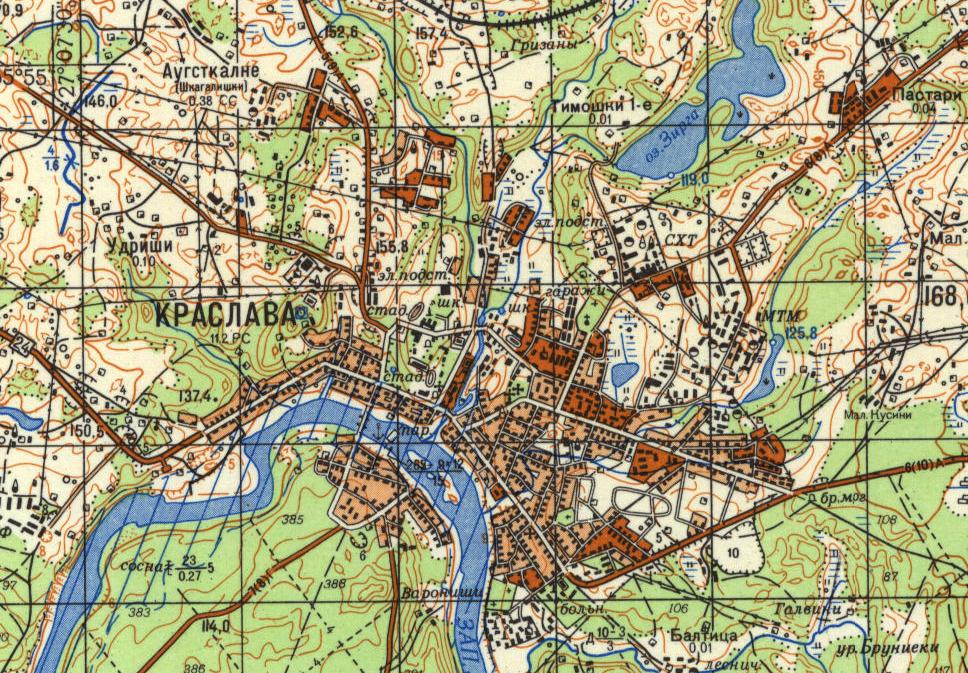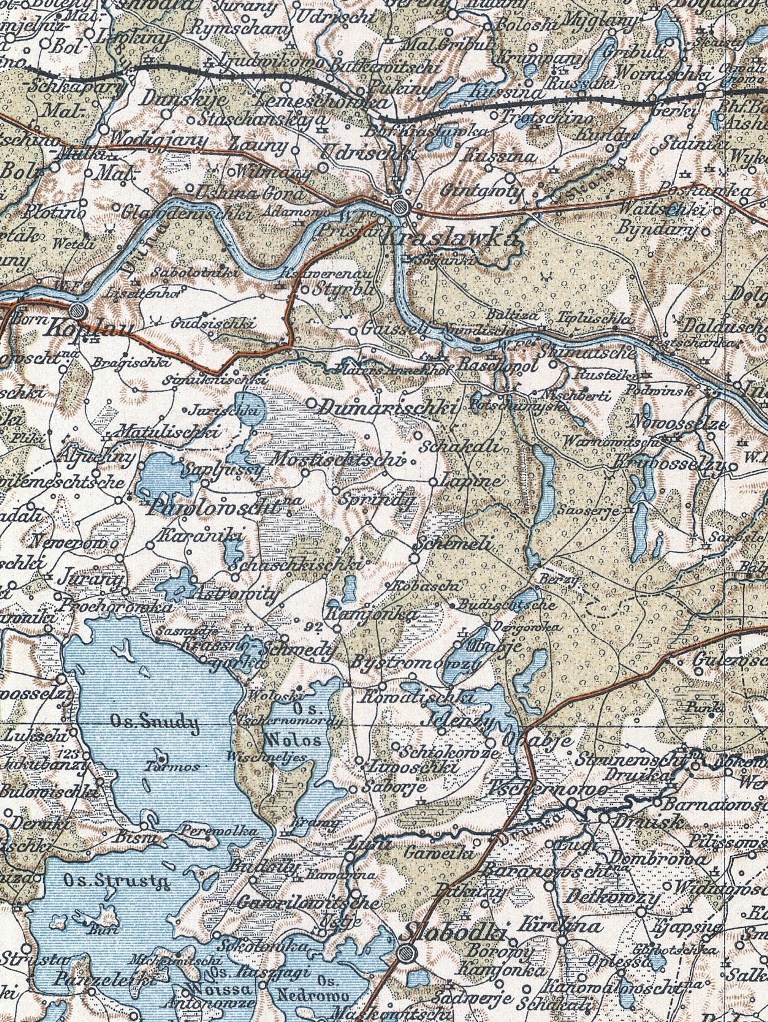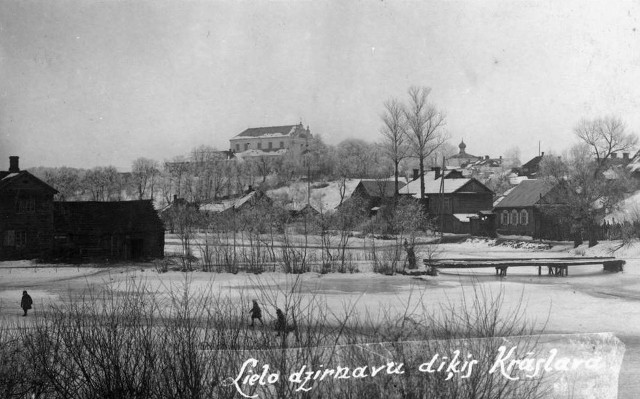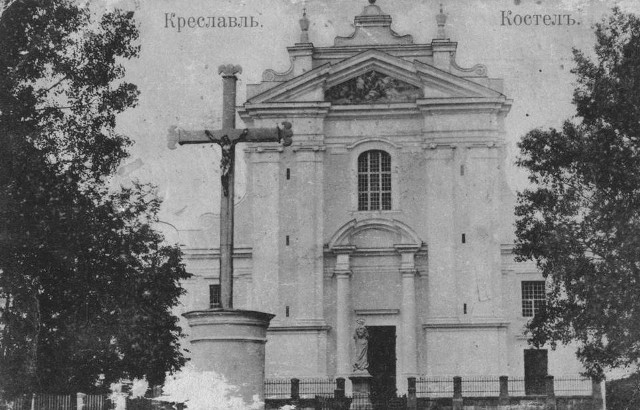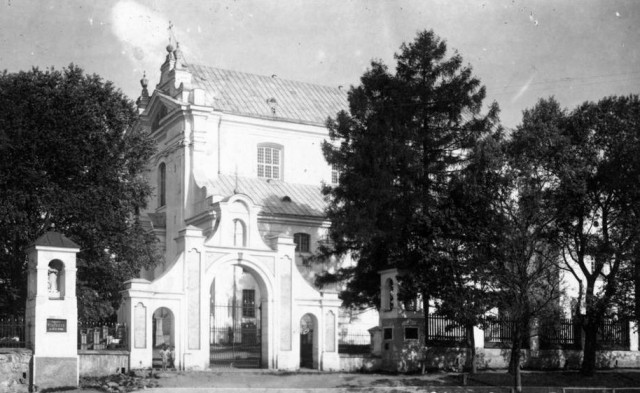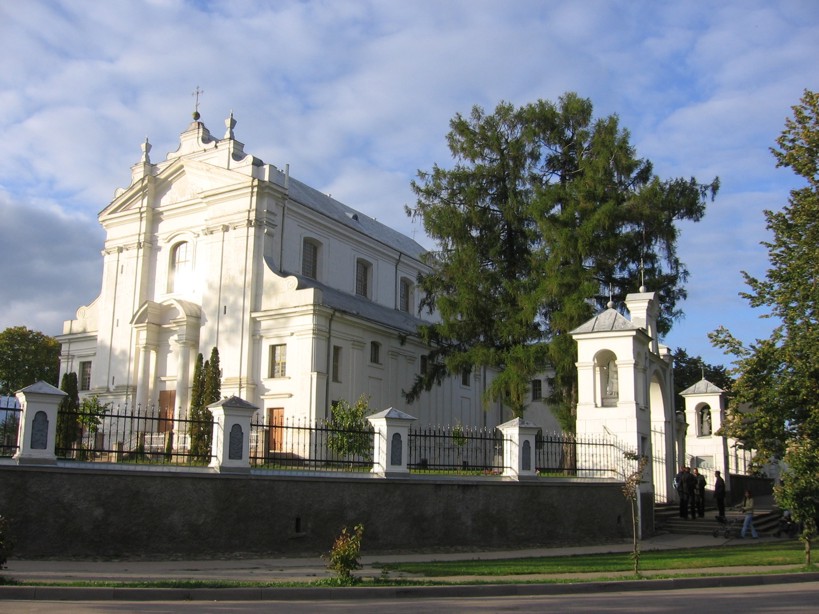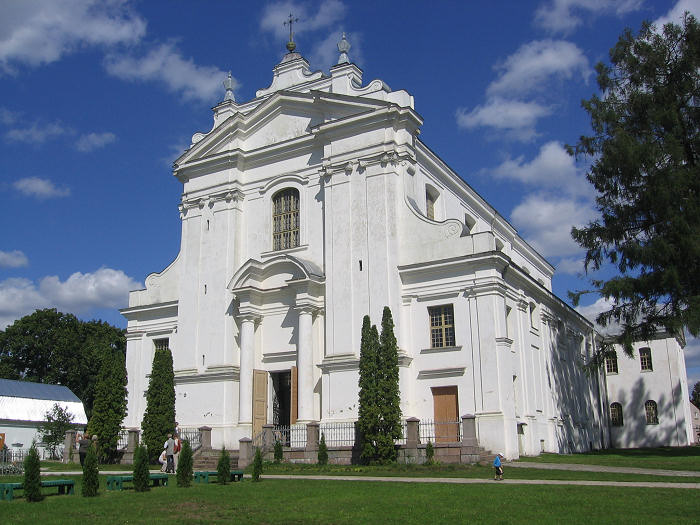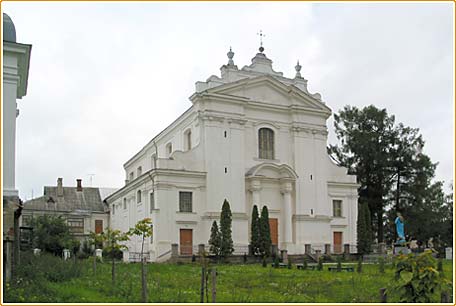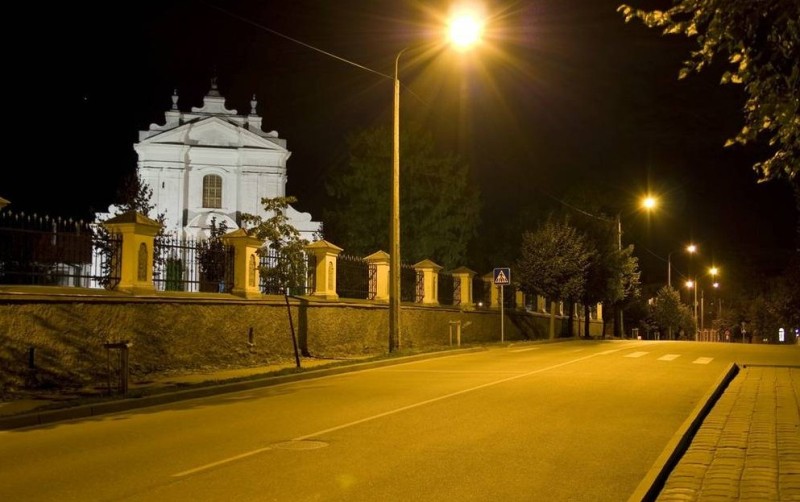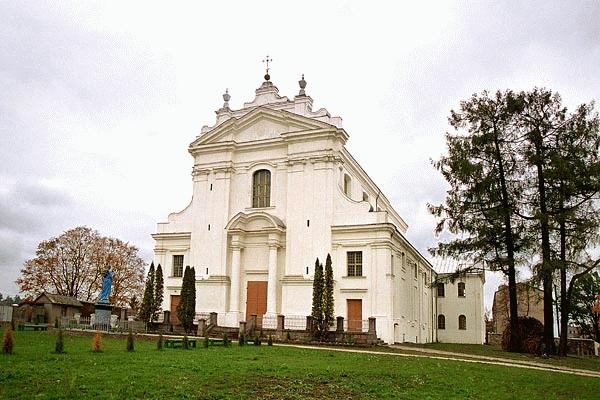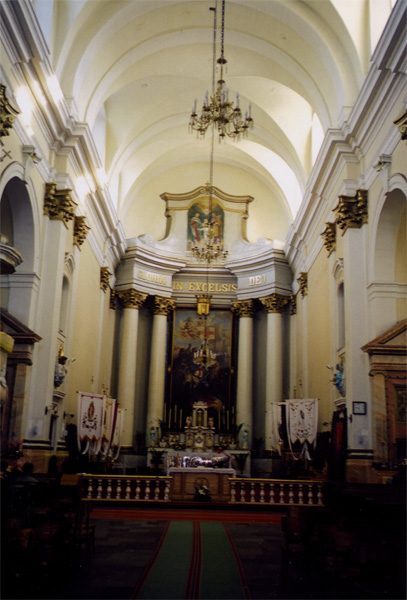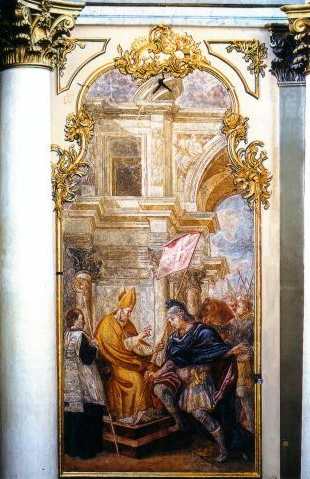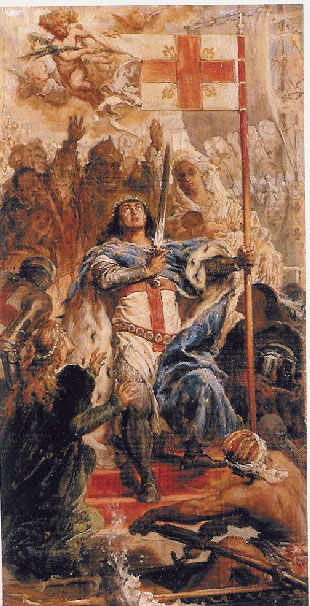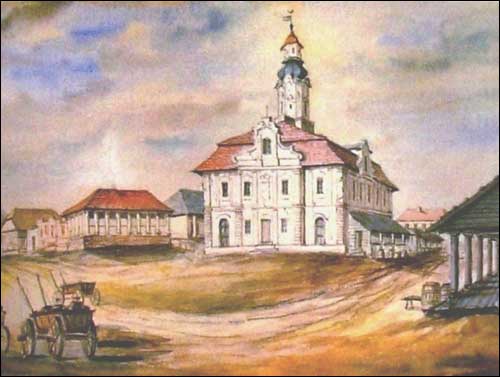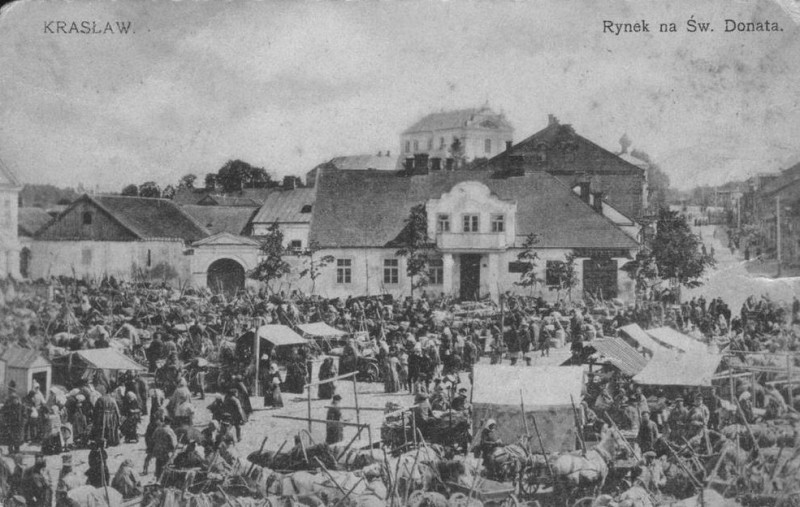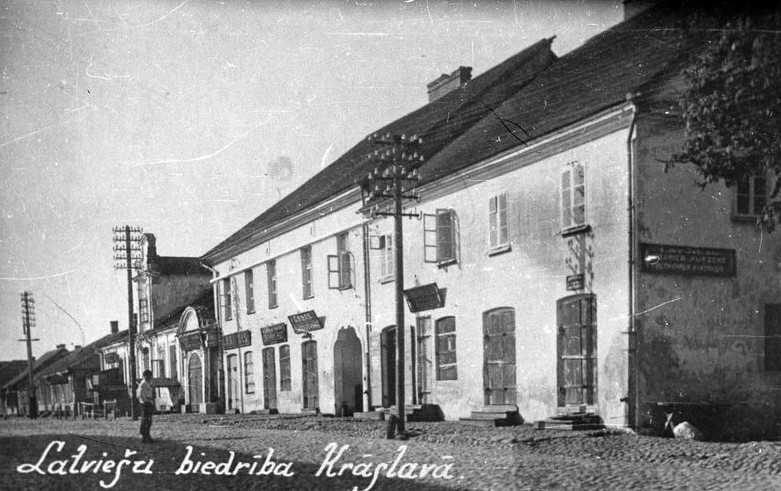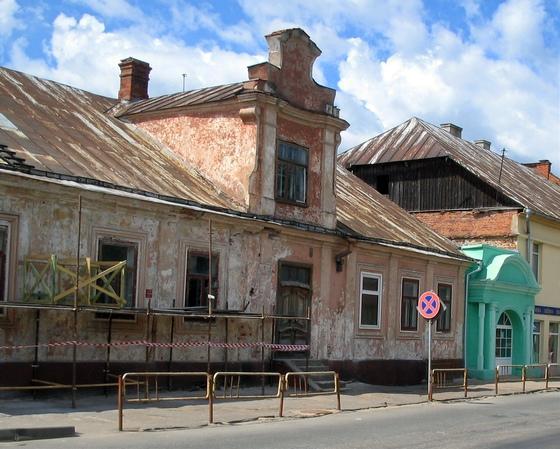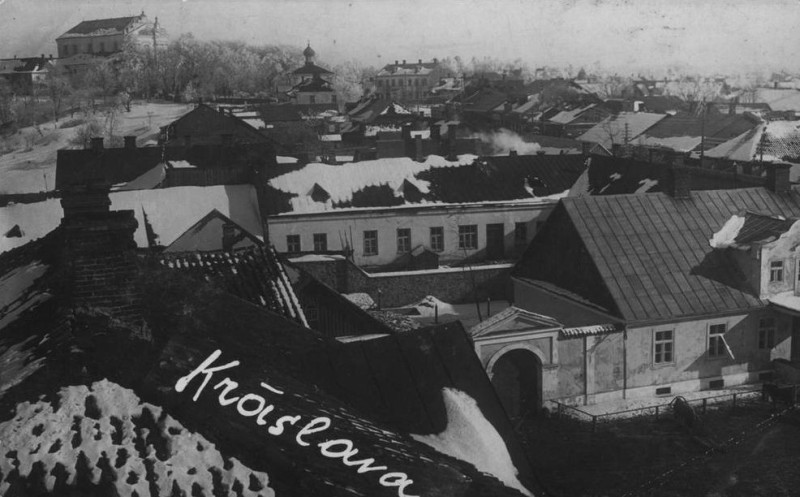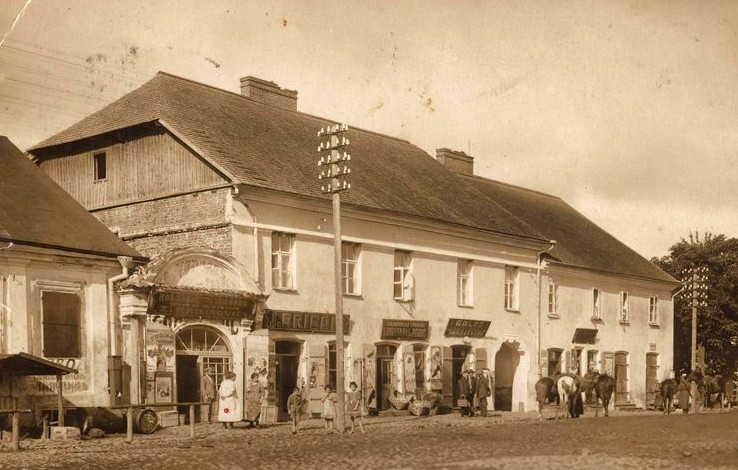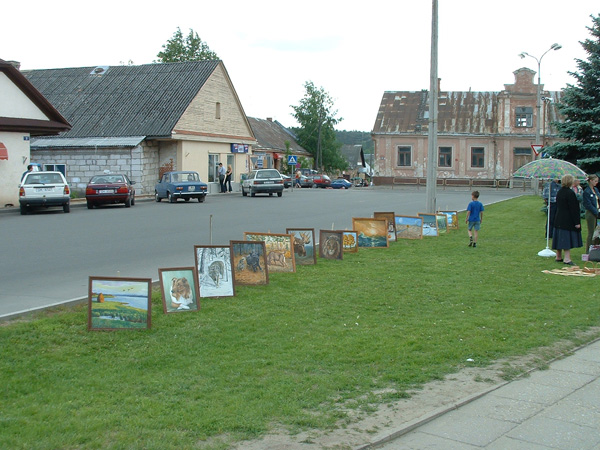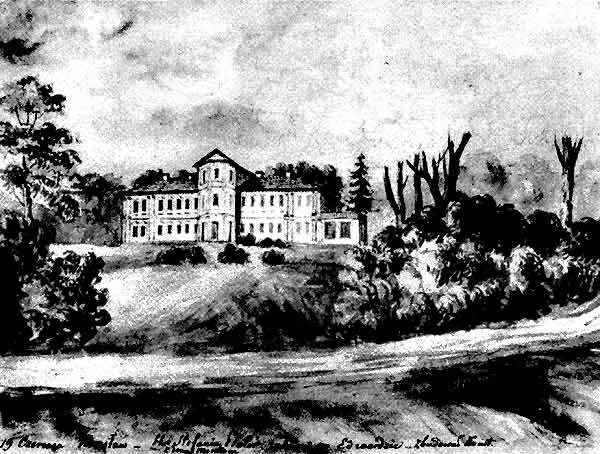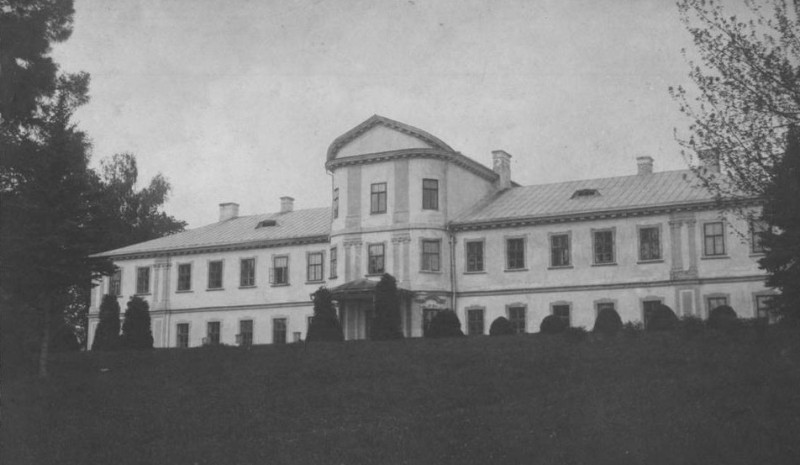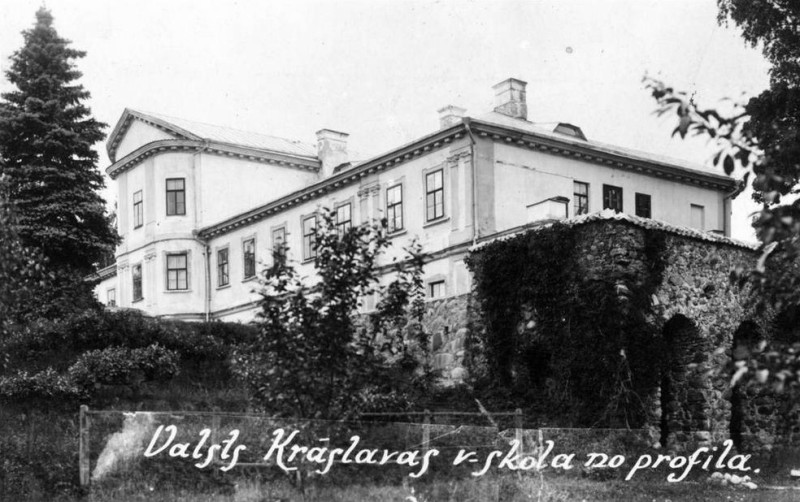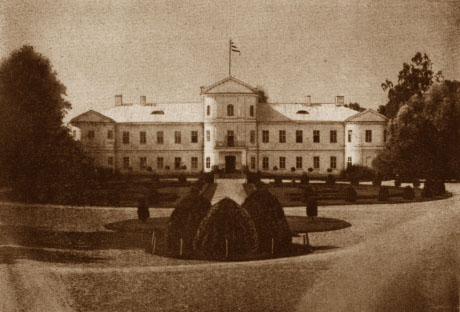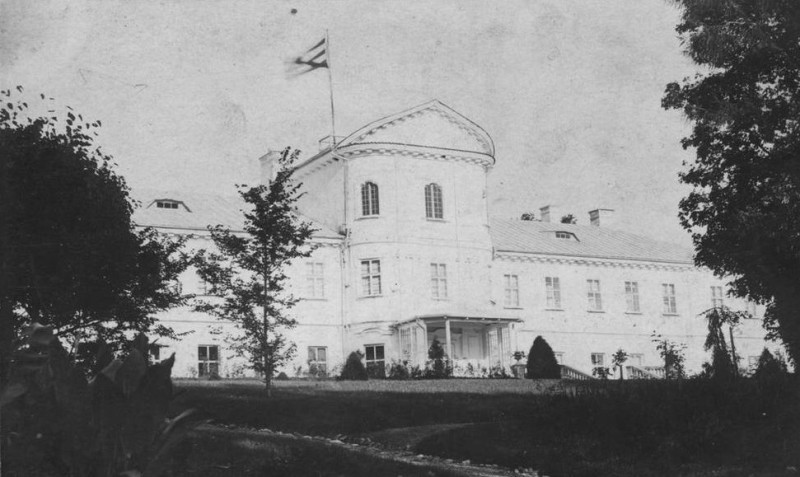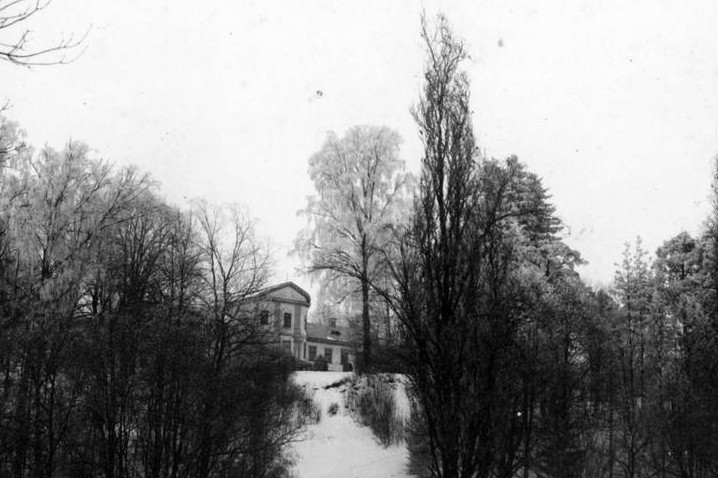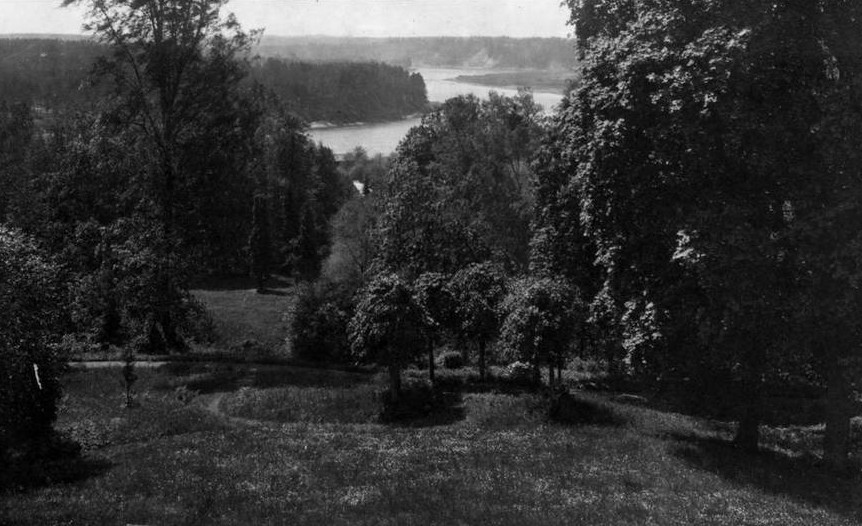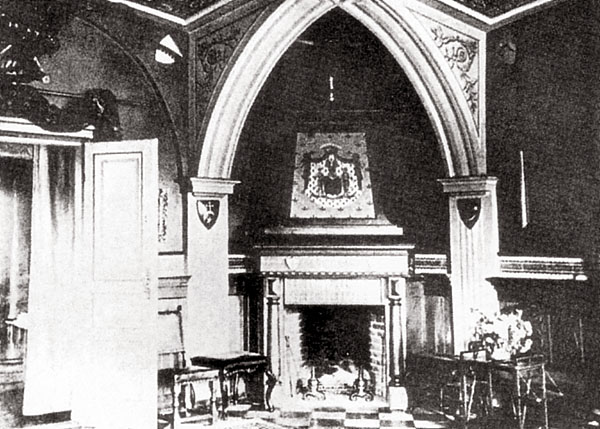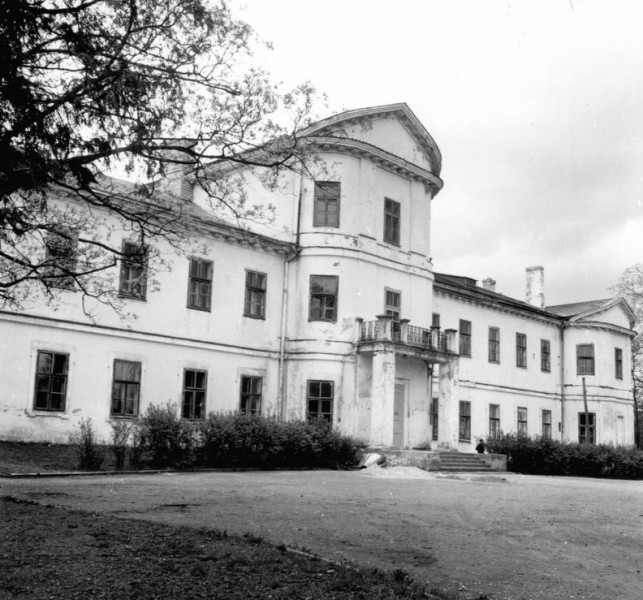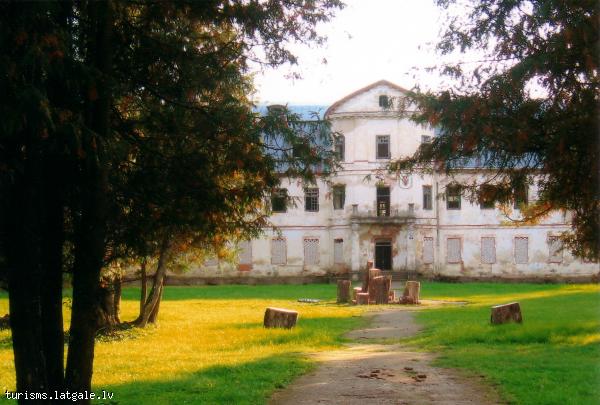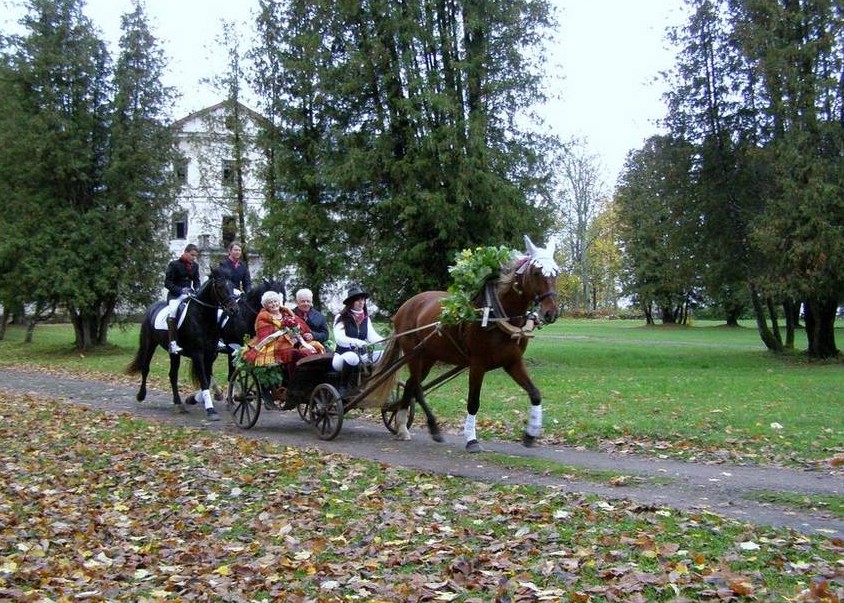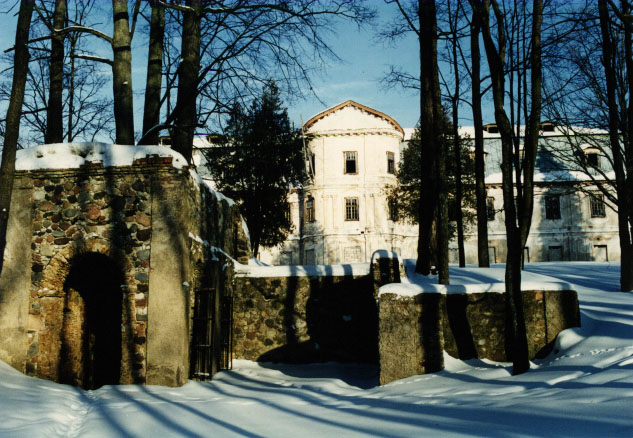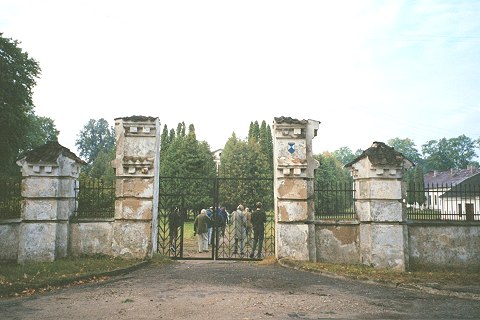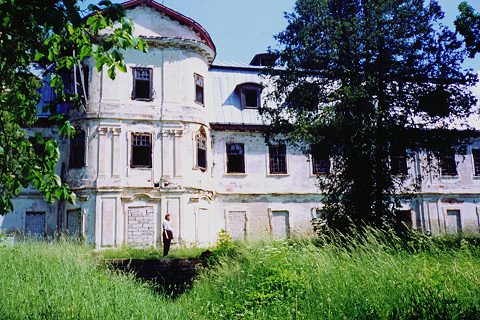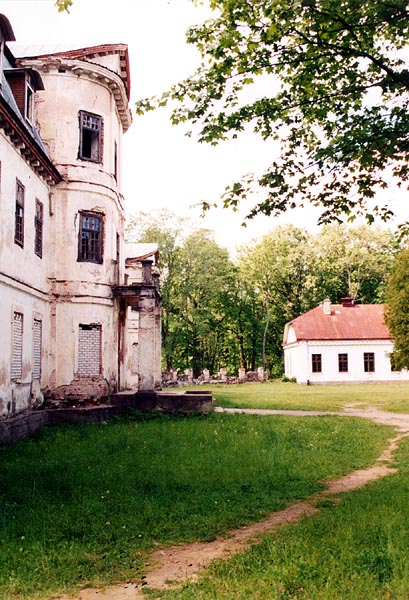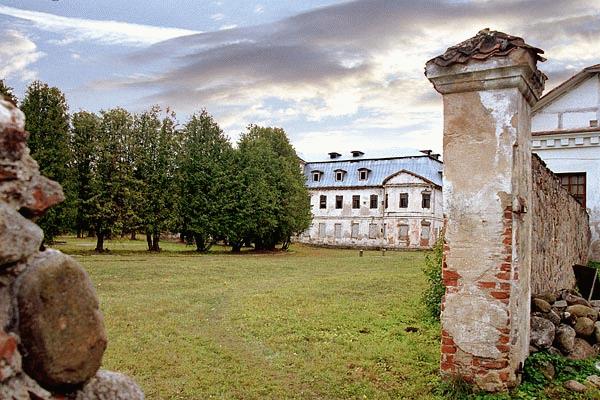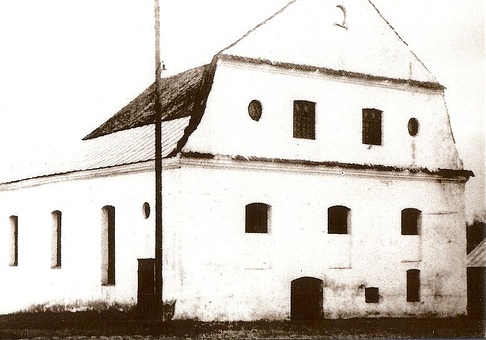
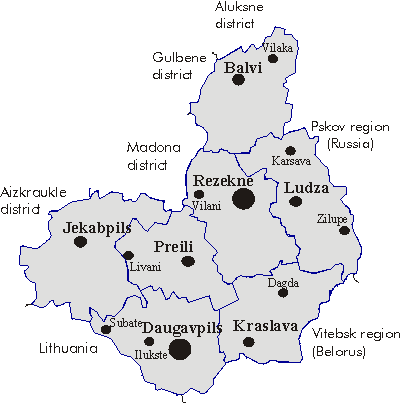

History of Kraslava - One
55°54'N, 27°10'E


Latgale, the Dvina River and Szlachta - The History of Kraslava
From Neolithic Times till the Eighteenth Century
From Neolithic Times till the Eighteenth Century
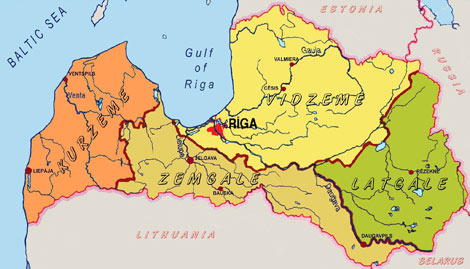
LATGALE
ZEMGALE
VIDZEME
COURLAND
RIGA
Russia
Lithuania
Belarus

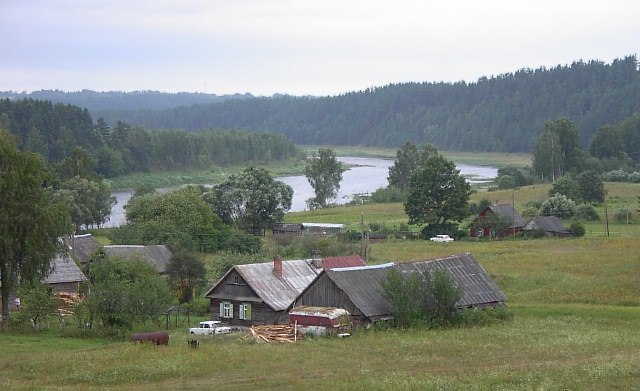



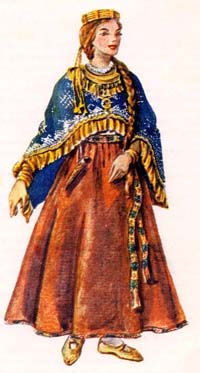

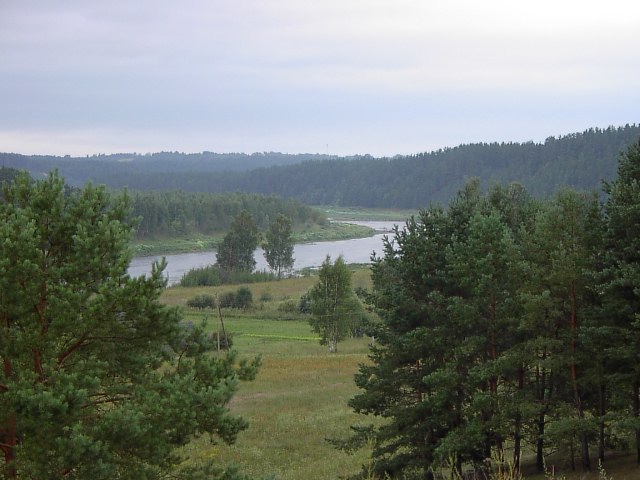
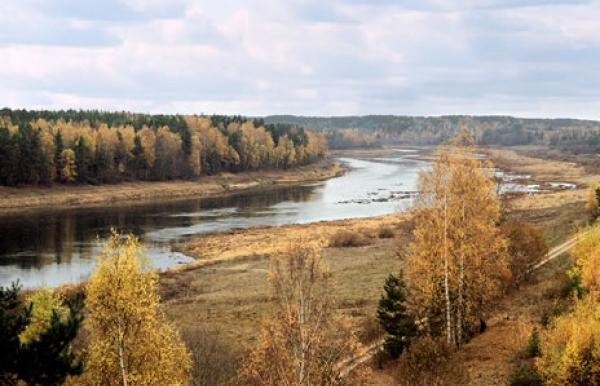

Scenes of Latgale & the Dvina (Daugava) River

Map of Latgale (Latgola)
The Region of Latgale
Latgale is the easternmost of the four cultural regions of Latvia. Divided from Belarus to the south by the Dvina (Daugava) river, the area has traditionally been the home to a variety of ethnic groups, with ethnic Russians still forming a large proportion of the population, and the majority in Dvinsk (Daugavpils), the largest city in the region. Being historically part of the Polish-Lithuanian commonwealth, there still remains a significant Polish minority. The region was also part of the Pale of Settlement and, until the Holocaust, had a large Jewish population, the Jews forming the largest ethnic group in most of the towns till their murder in 1941.
Originally Latgale was populated by the Eastern Balts, who spoke a language that became the Latgalian dialect of Latvian. During the 10th-12th centuries two principalities existed on the territory, but by the 13th century Latgale became a part of Lithuania, and later was conquered by the Teutonic Livonian Order and incorporated into Livonia. In the 16th century Latgale was annexed by Lithuania, and in 1569 was incorporated into the Polish-Lithuanian Commonwealth as the region of Inflanty.
Latgale is the easternmost of the four cultural regions of Latvia. Divided from Belarus to the south by the Dvina (Daugava) river, the area has traditionally been the home to a variety of ethnic groups, with ethnic Russians still forming a large proportion of the population, and the majority in Dvinsk (Daugavpils), the largest city in the region. Being historically part of the Polish-Lithuanian commonwealth, there still remains a significant Polish minority. The region was also part of the Pale of Settlement and, until the Holocaust, had a large Jewish population, the Jews forming the largest ethnic group in most of the towns till their murder in 1941.
Originally Latgale was populated by the Eastern Balts, who spoke a language that became the Latgalian dialect of Latvian. During the 10th-12th centuries two principalities existed on the territory, but by the 13th century Latgale became a part of Lithuania, and later was conquered by the Teutonic Livonian Order and incorporated into Livonia. In the 16th century Latgale was annexed by Lithuania, and in 1569 was incorporated into the Polish-Lithuanian Commonwealth as the region of Inflanty.
In 1772 Inflantia and its neighbours were annexed by the Russian Empire, and from 1865 a period of Russification began, during which the Latgalian language (written in Latin script) was forbidden, a prohibition only lifted in 1904. In 1920 Latgale was integrated with newly independent Latvia.
Latgale, popularly known as "The Land of Blue Lakes", is dotted with around one thousand lakes, the largest of which is Lake Razna. Much of Latgale is characterised by rolling hills, while the southern part of the region is a lowland area of considerable forests and numerous peat bogs that lead to the Dvina (Daugava) river. The Dvina is a navigable river and was a major economic artery throughout history. The river flows for a thousand kilometers from Riga on the Baltic coast, through Latgale to Polatsk, Vitebsk and thence through a series of canals the river connected to the Dnieper and on to the Black Sea. The major product floated down the river was timber from interior of Latvia, Belarus and Russia that was exported from Riga to western Europe.
Latgale, popularly known as "The Land of Blue Lakes", is dotted with around one thousand lakes, the largest of which is Lake Razna. Much of Latgale is characterised by rolling hills, while the southern part of the region is a lowland area of considerable forests and numerous peat bogs that lead to the Dvina (Daugava) river. The Dvina is a navigable river and was a major economic artery throughout history. The river flows for a thousand kilometers from Riga on the Baltic coast, through Latgale to Polatsk, Vitebsk and thence through a series of canals the river connected to the Dnieper and on to the Black Sea. The major product floated down the river was timber from interior of Latvia, Belarus and Russia that was exported from Riga to western Europe.
Map of Livonia in 1662 from the Blaeu Atlas
| Year | Population | Jews | % |
| 1766 | 840 | ||
| 1822 | 1500 | 733 | 50 |
| 1847 | 1483 | ||
| 1868 | 2000 | ||
| 1887 | 3160 | ||
| 1897 | 8000 | 4051 | 51 |
| 1914 | 5000 | ||
| 1920 | 2564 | 1446 | 41 |
| 1925 | 4485 | 1716 | 38 |
| 1930 | 4283 | 1550 | 36 |
| 1935 | 4276 | 1444 | 34 |
| 1944 | 40 families | ||
| 2007 | 10854 | 10? | 0.1 |

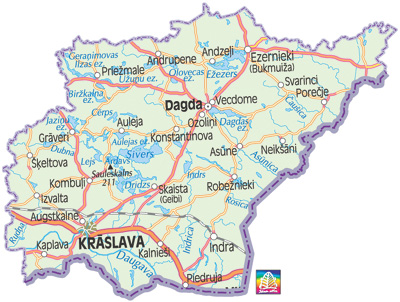
Population of Kraslava
Polish Map of Kraslaw Disrtict - 1933
Soviet Map of Kraslava - 1982
Modern Latvian Map of Kraslava District
Detail of Kraslava from Polish Map of 1933
Detail of Kraslava from Soviet Map of 1982
From Slobodka to Kraslava
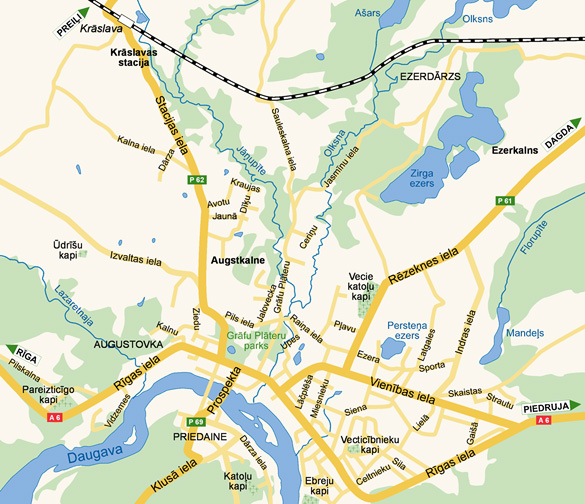
1
2
3
4
6
9
8
7
5
10
1 - Plater Estate
2 - Market Square
3 - St.Ludwig
Catholic Church
4 - Main Synagogue
5 - Jewish Cemetery
6 - Catholic Cemetery
7 - Plater Library
8 - Train Station
9 - Adamova Hill
10 - Orthodox Church
2 - Market Square
3 - St.Ludwig
Catholic Church
4 - Main Synagogue
5 - Jewish Cemetery
6 - Catholic Cemetery
7 - Plater Library
8 - Train Station
9 - Adamova Hill
10 - Orthodox Church
Early Times
The earliest evidence of settlement in Kraslava dates to the Neolithic Age (4th millenium BCE). Archaeological remains were found at a number of sites on the bank of the Dvina (Daugava), the river historically becoming a major trade route along which the economy developed and culture migrated. From early times the area was inhabited by Finno-Ugric tribes and later by Latgalians.
The origin of the name 'Kraslava' is not clear and a number of meanings are given. The name may be based on the ancient Latgalian word for a chair - 'krasls' that refers to the meanders of the Dvina that, according to legend, take the form of a chair. During the years that the Dvina was navigable these trecherous bends were a place where many craft came aground. Another version states that the name comes from the word 'krasla' - twilight, relating to the dark gloomy forest that surrounded the town. A further explanation connects the name to the people of Polotsk, further east along the Dvina, who called the bend in the river 'kras-lava' - a beautiful meadow. Certainly the area was connected to Polotsk in the 10th century when a legend states that Kraslava belonged to Princess Rogneda of Polotsk, who late married Vladimir of Kiev (Vladimir the Great). It was Vladimir who adopted Christianity as the state religion of Kievian Rus in 988 CE.
The earliest evidence of settlement in Kraslava dates to the Neolithic Age (4th millenium BCE). Archaeological remains were found at a number of sites on the bank of the Dvina (Daugava), the river historically becoming a major trade route along which the economy developed and culture migrated. From early times the area was inhabited by Finno-Ugric tribes and later by Latgalians.
The origin of the name 'Kraslava' is not clear and a number of meanings are given. The name may be based on the ancient Latgalian word for a chair - 'krasls' that refers to the meanders of the Dvina that, according to legend, take the form of a chair. During the years that the Dvina was navigable these trecherous bends were a place where many craft came aground. Another version states that the name comes from the word 'krasla' - twilight, relating to the dark gloomy forest that surrounded the town. A further explanation connects the name to the people of Polotsk, further east along the Dvina, who called the bend in the river 'kras-lava' - a beautiful meadow. Certainly the area was connected to Polotsk in the 10th century when a legend states that Kraslava belonged to Princess Rogneda of Polotsk, who late married Vladimir of Kiev (Vladimir the Great). It was Vladimir who adopted Christianity as the state religion of Kievian Rus in 988 CE.
Vladimir & Rogneda
Anton Lesenko - 1770
Anton Lesenko - 1770
Long ago, merchants navigated boats and rafts from the Baltic Sea to the Black Sea along the Dvina and on to the Dnieper. The boats were filled with goods - amber, silver, fur and other items of luxury. Near Kraslava the river was known to be dangerous and rough, and the merchants relied on the knowledge of local pilots. When the boatmen left, the beautiful girls of Kraslava saw them off and cried bitterly. The handsome watermen promised to return, so the girls waited for them on the bank of the Dvina. Sadly the days passed but the men never came back. With time the girls became mermaids, living at the river bottom.
They still appear on the river banks at night. When the moon reflects in the water, they sit on small rocks and wait for the boatmen till the first cock calls and then slip back into the cold, deep water until the moon shines over the river again.
They still appear on the river banks at night. When the moon reflects in the water, they sit on small rocks and wait for the boatmen till the first cock calls and then slip back into the cold, deep water until the moon shines over the river again.
The Mermaids of the Dvina

With the conquest of the area in the 13th century by the Teutonic Livonian Order, Kraslava came under their control. The Order constructed warehouses in the town for trade along the Dvina in the 14th century. From 1558 the Livonian Order established a base in Kraslava, which from 1562 was included in the the Duchy of Livonia. After the Polish-Swedish war (1600-29) Kraslava became part of Inflanty under the Polish-Lithuanian commonwealth, with its capital in nearby Dyneberg (Dvinsk).
The Decree of Catherine II in 1772 seperated Latgale from Poland and it was included in the new Dvinsk Uyezd (region) of the Pskov gubernia. By 1776 the Dvinsk region had been joined with the Vitebsk, Polotsk and Mogilev regions to form the Belarussian General Province with a capital in Vitebsk. The name of the gubernia (province) would change from time to time but remained under Russian Imperial control till the return to the name Latgale under independent Latvia after WWI.
The Decree of Catherine II in 1772 seperated Latgale from Poland and it was included in the new Dvinsk Uyezd (region) of the Pskov gubernia. By 1776 the Dvinsk region had been joined with the Vitebsk, Polotsk and Mogilev regions to form the Belarussian General Province with a capital in Vitebsk. The name of the gubernia (province) would change from time to time but remained under Russian Imperial control till the return to the name Latgale under independent Latvia after WWI.
Livonian Order

Inflanty
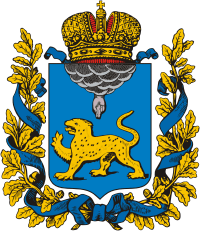
Pskov Gubernia
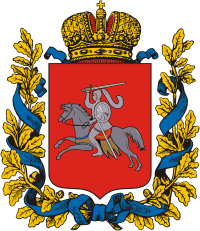
Belarussian Gubernia
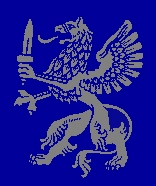
Enter the Szlachta - The Platers
The first reliable historical source for Kraslava dates as late as the 16th century, relating to the transfer of feudal ownership to members of the Polish landed nobility - the Szlachta. In 1558 the town became the property of Engelberta Plumpera. By 1569, through a special warrant of the Polish King Sigismund II Augustus, feudal pocession was granted to the Duke of Courland. During this time a small wooden Catholic church was built in the town. The town went through a quick series of ownership changes between Polish szhlachta; to the Jesuit jurist Ludinghauzen in 1676; to the Kosev family by order of the Polish king Jan III Sobieski; to the Czapski family 1725 until Kraslava was bought by Count Jan Ludwik Plater in January 1729. Count
The first reliable historical source for Kraslava dates as late as the 16th century, relating to the transfer of feudal ownership to members of the Polish landed nobility - the Szlachta. In 1558 the town became the property of Engelberta Plumpera. By 1569, through a special warrant of the Polish King Sigismund II Augustus, feudal pocession was granted to the Duke of Courland. During this time a small wooden Catholic church was built in the town. The town went through a quick series of ownership changes between Polish szhlachta; to the Jesuit jurist Ludinghauzen in 1676; to the Kosev family by order of the Polish king Jan III Sobieski; to the Czapski family 1725 until Kraslava was bought by Count Jan Ludwik Plater in January 1729. Count

Sigismund II Augustus

Jan III Sobieski

Plater Family
Coat of Arms
Coat of Arms
Jan Ludwik Plater was the Voivode of Latgale and his family ruled over the town for the next two centuries till their expulsion from their property prior to WWI. At the same time Kraslava was a recognised as a small town and consisted of fourty-seven buildings (some of stone), the Livony hotel, a postal courier station, a grain storehouse and two inns.
The Platers originated in Westphalia, arriving in the Baltics with the Teutonic crusades, settling in Latgale and then assimilating into Polish culture. As their influence spread Platers became as one of the significant noble families in Latgale, Poland, Belarus and Lithuania. Count Jan Ludwik Plater was an influential man in King Sigismund August II's court, receiving the title Voivode (Palatine or Overseer) of Livonia and Dyneburg (Dvinsk); commander of the army of Inflanty (Livonia) and member of the Polish Sejm.
After Jan Ludwik's death in 1726 his properties were inherited by his son Konstany Ludwik Plater, who held them till 1778. He too received the title and honours held by his father, but also those of castellan of Polotsk; Knight of the Order of the White Eagle; commander of the army; Knight of the Order of St. Alexander Nevsky and ambassador in Russia.
After Jan Ludwik's death in 1726 his properties were inherited by his son Konstany Ludwik Plater, who held them till 1778. He too received the title and honours held by his father, but also those of castellan of Polotsk; Knight of the Order of the White Eagle; commander of the army; Knight of the Order of St. Alexander Nevsky and ambassador in Russia.

Adamova hill and the Valley of Echoes
Once upon a time, one young man from Kraslava named Adam, decided to show the ancient Dvina valley to his fiancee Eva. While they walked and climbed, Eva slipped and fell into the river from a high hill. Where she fell her cry can still be heard and it became known as the Valley of Echoes. Adam remained faithful to Eva and is seen sitting and crying on the hill named after him, his tears turned the red clay white.
More importantly for Kraslava was the receipt of Magdeburg rights which encouraged development and the growth of trade. From 1737 to 1776 the town experienced rapid industrial development, making Kraslava a significant industrial and cultural centre well beyond its size. Construction work of the Town-Hall started in the main square and the Count invited tradesmen and craftsmen from Poland and Germany to develop the production of damask, jewellry, playing cards, stove and woven cloth. To encourage economic growth large annual fairs were held for merchants and purchasers.
The Count's Building Programme
From 1755, till his passing, Count Konstanty Plater sponsored a series of prestigious building projects with the aim of changing Kraslava's status to become the seat of the Bishopric of Livonia and district capital. These programme included a church, built as a cathedral for the Bishop; a town hall, a theological seminary, a library, schools, a palace set in landscaped gardens and a synagogue.
From 1755, till his passing, Count Konstanty Plater sponsored a series of prestigious building projects with the aim of changing Kraslava's status to become the seat of the Bishopric of Livonia and district capital. These programme included a church, built as a cathedral for the Bishop; a town hall, a theological seminary, a library, schools, a palace set in landscaped gardens and a synagogue.
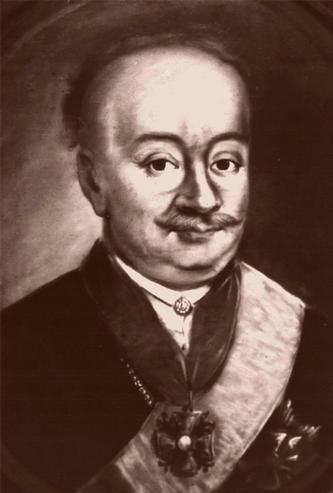
Count Konstanty Ludwik Plater
1722 - 1778
1722 - 1778
KRASLAVA
St. Ludwik Catholic Church
The construction of a magnificient church was a central part of the Platers’ grandiose plans to make Kraslava the centre of spiritual and secular life for Livonia and for their extended family. The main aim was to build a church that would be the seat of the Catholic Bishop of Inflanty (Livonia), a plan scuttled by the partion of Poland and the annexation of much of its territory, including Latgale, to Imperial Russia in 1772. The building of a the stone church, named for St. Ludwik (Saint Louis IX of France), commenced in 1755, was based on the plans of the Italian architect Antonio Paracco. The Kraslava church is one of the most important examples of Late Baroque architecture in Latgale. The construction ended in 1767, before the project was completed, leaving two towers unbuilt. Indeed, the walls were only plastered in 1830, the stairs added in 1832 and the belfry in 1838.
The edifice is a stone basilica with a projecting chancel as an extension of the nave and two extensions that include the former seminary building and St. Donat’s chapel added in 1818. The interior is designed in modest Baroque forms, the main hall covered with barrel and groin vaults. The altar piece “Svetais Ludviks dodas krusta kara” is a painting of King Louis IX (Saint Ludwik-Louis) of France departing for the Crusades, painted in 1884 by the Polish artist T. Lisiewicz, after the draft of Polish painter Jan Matejko, and one of the most significant pieces of art in Latvia. Recent restoration shows it to have been painted over an earlier fresco of the same scene by Filippo Castaldi.
The construction of a magnificient church was a central part of the Platers’ grandiose plans to make Kraslava the centre of spiritual and secular life for Livonia and for their extended family. The main aim was to build a church that would be the seat of the Catholic Bishop of Inflanty (Livonia), a plan scuttled by the partion of Poland and the annexation of much of its territory, including Latgale, to Imperial Russia in 1772. The building of a the stone church, named for St. Ludwik (Saint Louis IX of France), commenced in 1755, was based on the plans of the Italian architect Antonio Paracco. The Kraslava church is one of the most important examples of Late Baroque architecture in Latgale. The construction ended in 1767, before the project was completed, leaving two towers unbuilt. Indeed, the walls were only plastered in 1830, the stairs added in 1832 and the belfry in 1838.
The edifice is a stone basilica with a projecting chancel as an extension of the nave and two extensions that include the former seminary building and St. Donat’s chapel added in 1818. The interior is designed in modest Baroque forms, the main hall covered with barrel and groin vaults. The altar piece “Svetais Ludviks dodas krusta kara” is a painting of King Louis IX (Saint Ludwik-Louis) of France departing for the Crusades, painted in 1884 by the Polish artist T. Lisiewicz, after the draft of Polish painter Jan Matejko, and one of the most significant pieces of art in Latvia. Recent restoration shows it to have been painted over an earlier fresco of the same scene by Filippo Castaldi.
The Catholic Church of St. Ludwik
Altar
St. Ludwik
Kraslava
St. Ludwik
Kraslava
St. Ludwik
Castaldi
Kraslava
Castaldi
Kraslava
St. Ludwik
Lisiewicz
Kraslava
Lisiewicz
Kraslava
The Kraslav church also houses the relics of the martyr St. Donat, attracting pilgrims to pray at the resting place of the patron Saint of the town. The relics were granted to the Platers by Pope Pius VI in 1778 and brought to Kraslava where the Metropolitan of Mogilev placed them in a glass box on the altar in Count Platers family chapel. In 1818 a separate chapel was constructed by Countess Augustina Oginska Plater for the relics.
In the summer 1941, after Red Army’s retreat, the church was fired, destroying St. Donat’s altar and the organ. The church was restored in 1942 under Nazi rule and the relics were placed in a niche in the wall.
In the summer 1941, after Red Army’s retreat, the church was fired, destroying St. Donat’s altar and the organ. The church was restored in 1942 under Nazi rule and the relics were placed in a niche in the wall.
The Market Square and the Town Hall
The post road from Riga to Moscow led through Kraslava directly into the Market square, a rectangular esplanade edged by one and two-storeyed wooden and stone buildings. These were merchants and craftsmen’s dwellings, stables, shops and trade buildings.
The oldest building on the Market square was a hotel-inn consisting of three single-storey stone buildings, constructed in the highly ornate Baroque style. At the corner of the square was a chemist’s shop built in 1729 from stone. Originally the building had an attic and a little balcony with a balustrade. The first documentation dates to 1810 when Martin Bonin acquired the establishment from Yakov Shimansky.
The post road from Riga to Moscow led through Kraslava directly into the Market square, a rectangular esplanade edged by one and two-storeyed wooden and stone buildings. These were merchants and craftsmen’s dwellings, stables, shops and trade buildings.
The oldest building on the Market square was a hotel-inn consisting of three single-storey stone buildings, constructed in the highly ornate Baroque style. At the corner of the square was a chemist’s shop built in 1729 from stone. Originally the building had an attic and a little balcony with a balustrade. The first documentation dates to 1810 when Martin Bonin acquired the establishment from Yakov Shimansky.
On the eastern side of the square was the Town Hall built by the architect Jan Tobias Didreshtain in 1752. The Town Hall was a square structure with a central tower topped with a weathercock. The Baroque design was typical of the Polish town halls of the eighteenth century. On the first floor was a customs house, a room for regulating weights and measures, a guard room and a prison cell. On the second was an entrance hall that led to the court-rooms, on the right a hall for civil cases, and on the left another for criminal cases. The courts lost their function following administrative changes under Russian rule and the Town Hall fell into disuse. In 1891 the tower and the second floor were demolished and a cultural centre was opened there in 1958.
Kraslava Town Hall in the Eighteenth Century
The Market Square - Then and Now
Note Catholic St. Ludwik & Orthodox Alexander Nevsky in Background
Note Catholic St. Ludwik & Orthodox Alexander Nevsky in Background
Market Day
Shops on the Market Square
Kraslava Ecclesiastical Seminary
The ecclesiastical seminary, the first higher educational establishment in Latvia, opened in 1757. Located in an old building close to the church, the seminary was operated initially by the Jesuits. Bishop Antony Ostrovsky invited Vincentian Fathers to Kraslava to help organise and instruct in the new ecclesiastical seminary, and to prepare new priests for Latgale and Belarus. Funding was provided by the Bishop of Minsk and local prosperous landowners. After graduating the seminary pupils could continue studying in the higher Vilnius University founded by Cardinal Jerzy Radziwill under Jesuit instruction.
As a result of Latgale’s annexation to Russia in 1772 donations were no longer readly available and some of the funds were transferred to Mogilev, leading to the closure of the institution. During the 86 years of its existence the seminary prepared 253 priests, many continuing their education to become Bishops and Professors of ecclesiastics.
The Vincentians also took control of Kraslava's schools from the Jesuits. After the fire of 1826 destroyed many houses and the school the Fathers lacked the resources to rebuild and the district school transferred to Rezekne. In 1789 a nunnery and girls school was founded by the Daughters of Charity of St. Vincent de Paul (Servants of the Sick Poor).
.
The ecclesiastical seminary, the first higher educational establishment in Latvia, opened in 1757. Located in an old building close to the church, the seminary was operated initially by the Jesuits. Bishop Antony Ostrovsky invited Vincentian Fathers to Kraslava to help organise and instruct in the new ecclesiastical seminary, and to prepare new priests for Latgale and Belarus. Funding was provided by the Bishop of Minsk and local prosperous landowners. After graduating the seminary pupils could continue studying in the higher Vilnius University founded by Cardinal Jerzy Radziwill under Jesuit instruction.
As a result of Latgale’s annexation to Russia in 1772 donations were no longer readly available and some of the funds were transferred to Mogilev, leading to the closure of the institution. During the 86 years of its existence the seminary prepared 253 priests, many continuing their education to become Bishops and Professors of ecclesiastics.
The Vincentians also took control of Kraslava's schools from the Jesuits. After the fire of 1826 destroyed many houses and the school the Fathers lacked the resources to rebuild and the district school transferred to Rezekne. In 1789 a nunnery and girls school was founded by the Daughters of Charity of St. Vincent de Paul (Servants of the Sick Poor).
.
The Plater Family Estate
Count Konstanty Ludwik Plater's most significant project was the construction of a new palace, consecrated in 1791. It was large white washed two - storey stone building with a garret roof. The building was designed by Jan Tobias Didreshtain in close collaboration with the Italian Antonio Paracco. The internal walls were decorated with paintings depicting architectural elements, garlands of flowers, figurative images and Roman landscapes. The palace was set in a 22 hectare park, separated from the town by a stone wall and was landscaped down a slope with picturesque vistas over the Dvina river. The main section was a Baroque garden, geometrically planted with lime trees dotted with follies and a hot house and a luxuriant terraced park laid with exotic trees and bushes. At the side of the estate were built houses for servants, stables, tool sheds, cold cellars and a nursery for peasants.
The Plater Estate in its Prime
Note Plater Flag Flying over the Central Tower and Well Tended Formal Gardens
Note Plater Flag Flying over the Central Tower and Well Tended Formal Gardens
The Plater Estate in its Decline
The Sorry State of the now Crumbling Plater Estate
The Sorry State of the now Crumbling Plater Estate
The Plater Estate Outhouses - Now the Kraslava Museum
The Library
In keeping with his policy to strengthen Kraslava politically and culturally, Konstanty Ludwik Plater built a three storeyed Baroque library in 1759 in the eastern part of the estate parkland, again according to the plans drawn by Antonio Paracco. The institution containing 20000 volumes, atlases and manuscripts and was one of the largest libraries in the region. By the 19th century the Platers no longer longer had the funds for the upkeep and the books were sold off. The building later became a post office and then a primary school after Latvian independence.
The First Hospital
In 1789 Countess Augustina Oginska Plater donated 100 thousand gold pieces to care for the sick, poor and crippled people of Kraslava. The money was used to build a hospital, the first medical institution in Latgale, with male and female wards, dormitories for nurses and other facilities. Count Plater invited Esay Jacob Frank from Berlin to come to Kraslava as the Plater family doctor and first director of the hospital. Frank, who had studied at the University in Vilna, became the member of Vilna medical society in 1807. The next Kraslava doctor was Ernst Ehler, a graduate of Tartu University, who worked at the hospital from 1813 to the end of 1869. Being the only hospital in the region, people travelled there from Belarus and Lithuania for medical treatment.
In keeping with his policy to strengthen Kraslava politically and culturally, Konstanty Ludwik Plater built a three storeyed Baroque library in 1759 in the eastern part of the estate parkland, again according to the plans drawn by Antonio Paracco. The institution containing 20000 volumes, atlases and manuscripts and was one of the largest libraries in the region. By the 19th century the Platers no longer longer had the funds for the upkeep and the books were sold off. The building later became a post office and then a primary school after Latvian independence.
The First Hospital
In 1789 Countess Augustina Oginska Plater donated 100 thousand gold pieces to care for the sick, poor and crippled people of Kraslava. The money was used to build a hospital, the first medical institution in Latgale, with male and female wards, dormitories for nurses and other facilities. Count Plater invited Esay Jacob Frank from Berlin to come to Kraslava as the Plater family doctor and first director of the hospital. Frank, who had studied at the University in Vilna, became the member of Vilna medical society in 1807. The next Kraslava doctor was Ernst Ehler, a graduate of Tartu University, who worked at the hospital from 1813 to the end of 1869. Being the only hospital in the region, people travelled there from Belarus and Lithuania for medical treatment.
The Synagogue
(click for the page on the Jewish community of Kraslava)
At the invitation of the Platers a Jewish community was established in Kraslava early in the 18th century. The community soon became the largest ethnic group in Kraslava. The central place of the Jews in the life of the town was recognised by the 'poretz' (szlachta / landowner) and the Platers, in keeping with their policy of benevolence, donated funds in 1764 to build a large synagogue. The large white-washed, two storey structure was one of the earliest purpose built stone synagogues in Latgale, existing till its destruction during the holocaust.
(click for the page on the Jewish community of Kraslava)
At the invitation of the Platers a Jewish community was established in Kraslava early in the 18th century. The community soon became the largest ethnic group in Kraslava. The central place of the Jews in the life of the town was recognised by the 'poretz' (szlachta / landowner) and the Platers, in keeping with their policy of benevolence, donated funds in 1764 to build a large synagogue. The large white-washed, two storey structure was one of the earliest purpose built stone synagogues in Latgale, existing till its destruction during the holocaust.
The Kraslava Main Synagogue
Copyright © 2008 Jon Seligman. All Rights Reserved.
For Kraslava History from the end of the 18th century till today click HERE.
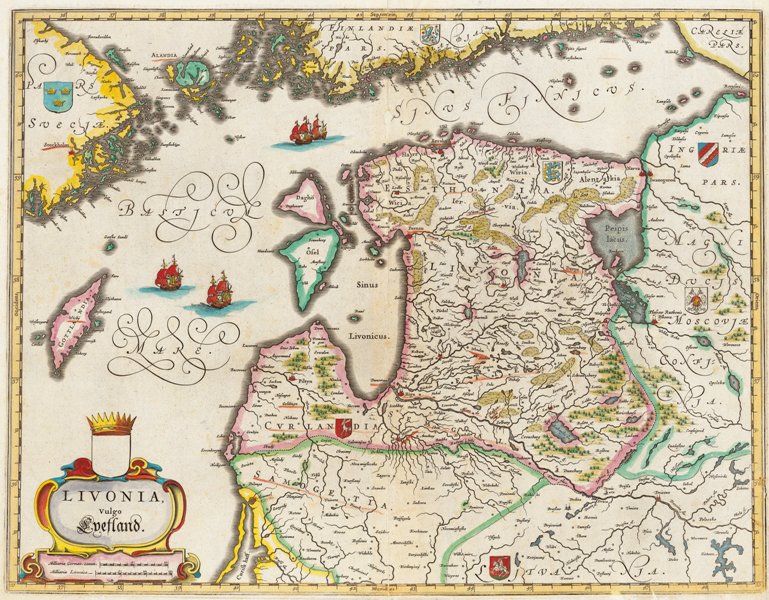
_300dpiB.jpg)
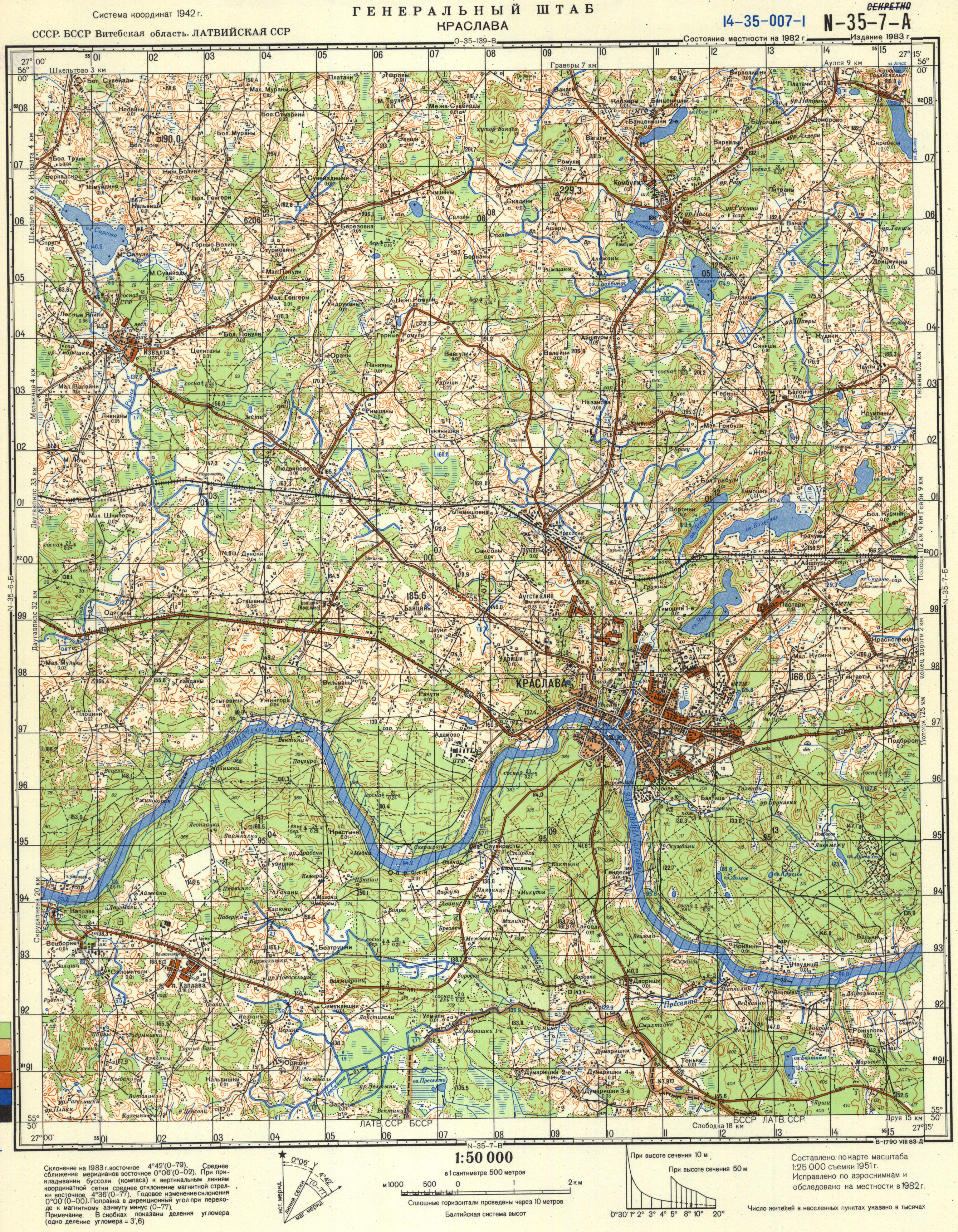
_300dpiA.jpg)
